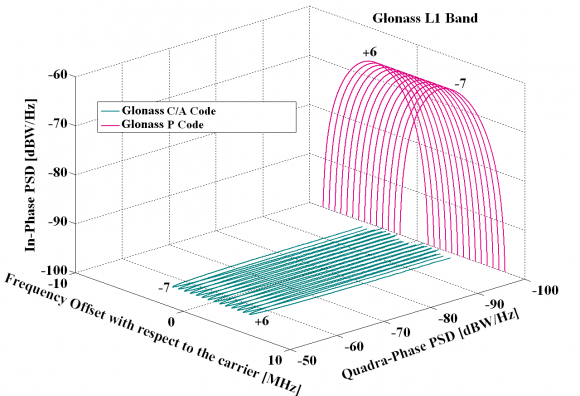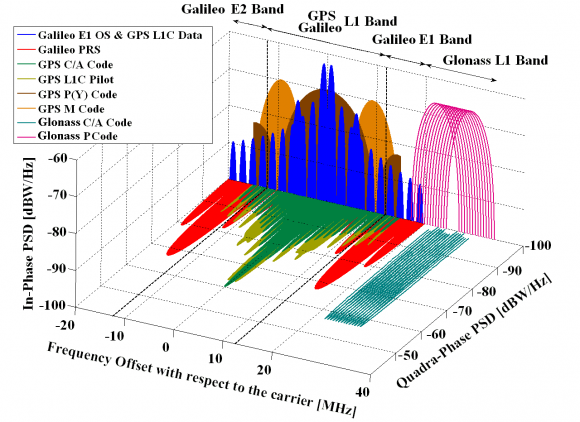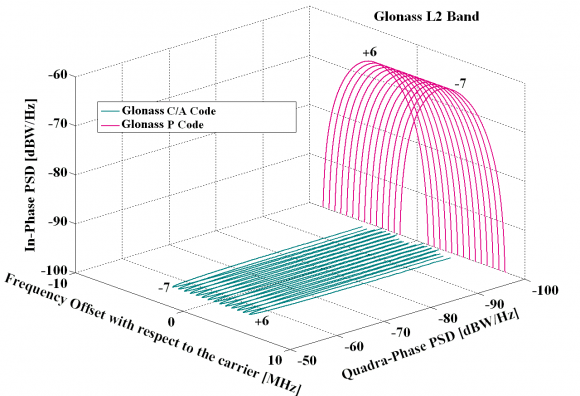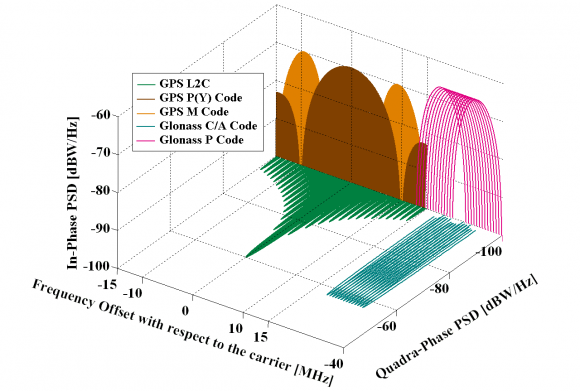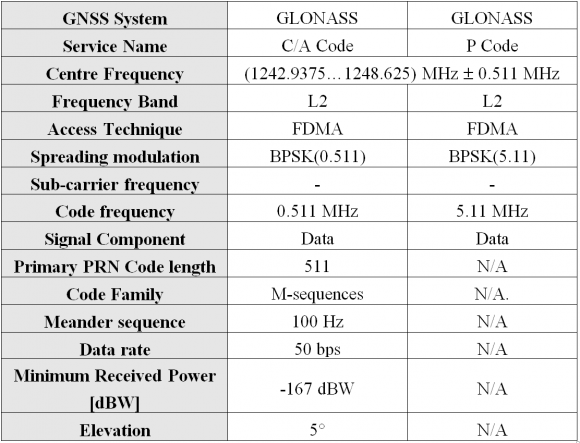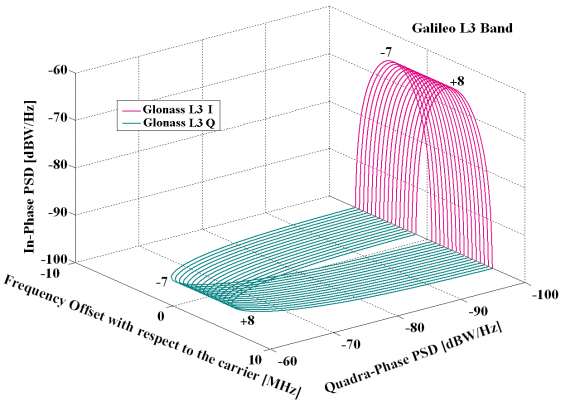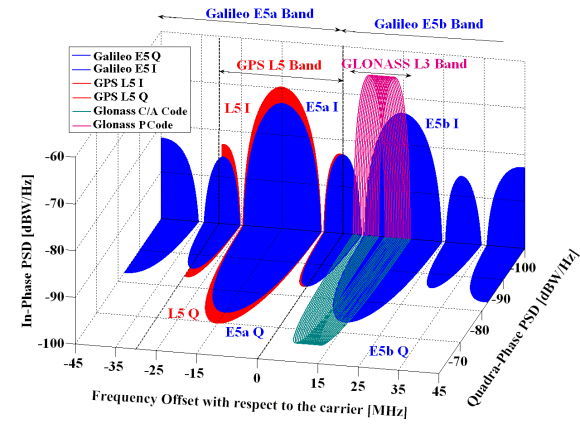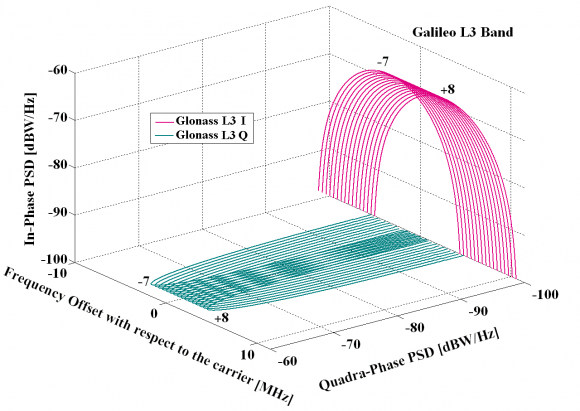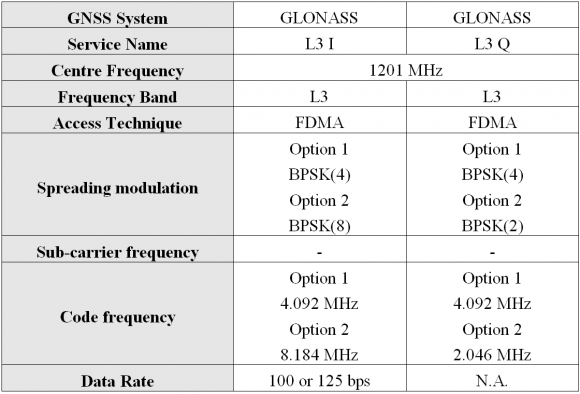If you wish to contribute or participate in the discussions about articles you are invited to contact the Editor
GLONASS Signal Plan: Difference between revisions
Carlos.Lopez (talk | contribs) No edit summary |
Carlos.Lopez (talk | contribs) No edit summary |
||
| Line 2: | Line 2: | ||
|Category=Fundamentals | |Category=Fundamentals | ||
|Title={{PAGENAME}} | |Title={{PAGENAME}} | ||
|Authors= J.A Ávila | |Authors= J.A Ávila Rodríguez, University FAF Munich, Germany. | ||
|Level=Advanced | |Level=Advanced | ||
|YearOfPublication=2011 | |YearOfPublication=2011 | ||
Revision as of 14:33, 19 September 2011
| Fundamentals | |
|---|---|
| Title | GLONASS Signal Plan |
| Author(s) | J.A Ávila Rodríguez, University FAF Munich, Germany. |
| Level | Advanced |
| Year of Publication | 2011 |
As it was mentioned at the beginning of this chapter, GLONASS, unlike the other GNSS systems, makes use of a different DSSS technique [G.W. Hein et al., 2006c][1] based on Frequency Division Multiple Access (FDMA) to transmit its ranging signals.
GLONASS uses FDMA in both the L1 and L2 sub-bands. According to this scheme, each satellite transmits navigation signals on its own carrier frequency, so that two GLONASS satellites may transmit navigation signals on the same carrier frequency if they are located in antipodal slots of a single orbital plane [GLONASS ICD, 2002] [2]. Indeed the actual constellation is taking advantage of this property since 2005 when the higher frequency channels had to be turned off to fulfil the CCIR Recommendation 769. We can clearly see this if we have a look at the satellites assigned to each of the GLONASS planes as shown in the following figure with status as of May 2008. As is clear to see, antipodal satellites are transmitting at the same frequency.
The red slots indicate that the satellite is in maintenance. Blue means correct operation. Moreover, two different types of signals [GLONASS ICD, 2002] [2] are transmitted by GLONASS satellites: Standard Precision (SP) and High Precision (HP) in both the L1 and L2 bands. The GLONASS standard accuracy signal, also known as C/A Code, has a clock rate of 0.511 MHz and is designed for use by civil users worldwide while the high accuracy signal (P Code) has a clock rate of 5.11 MHz and is modulated by a special code which is only available to users authorized by the Ministry of Defence. Since GLONASS-M, both L1 and L2 provide users with the standard accuracy code C/A. Moreover, the modernized GLONASS will also transmit FDMA signals on the L3 band and CDMA signals in L1 and L5.
The nominal values of the FDMA L1, L2 and L3 carrier frequencies are defined as:
- [math]\displaystyle{ \begin{array}{r} f_{k_L1} = f_{0_{L1}}+ k\Delta f_{L1}\\[0.3cm] f_{k_L2} = f_{0_{L2}}+ k\Delta f_{L2}\\[0.3cm] f_{k_L3} = f_{0_{L3}}+ k\Delta f_{L3}\\ \end{array} \qquad \mbox{(1)} }[/math]
- where:
- [math]\displaystyle{ k }[/math] represents the frequency channel,
- [math]\displaystyle{ f_{0_{L1}} }[/math] = 1602 MHz for the GLONASS L1 band,
- [math]\displaystyle{ \Delta f_{L1} }[/math] = 562.5 kHz frequency separation between GLONASS carriers in the L1 band,
- [math]\displaystyle{ f_{0_{L2}} }[/math] = 1246 MHz for the GLONASS L2 band,
- [math]\displaystyle{ \Delta f_{L2} }[/math] = 437.5 kHz frequency separation between GLONASS carriers in the L2 band,
- [math]\displaystyle{ f_{0_{L3}} }[/math] = 1201 MHz for the GLONASS L3 band, and
- [math]\displaystyle{ \Delta f_{L3} }[/math] = 437.5 kHz frequency separation between GLONASS carriers in the L3 band.
As we can see, the GLONASS L2 carrier reference signal is 7/9 of the L1 carrier reference and the GLONASS L3 carrier reference is 3/4 of the L1 carrier reference. Moreover, it must be noted that until 2005 the GLONASS satellites used the frequency channels k = 0,...,12 without any restrictions and the channel numbers k = 0 and 13 for technical purposes.
Since then GLONASS is only using the frequency channels k = -7,...,+6 and all the satellites launched beyond that year will use filters, limiting out-of-band emissions to the harmful interference limit contained in CCIR-ITU Recommendation 769 for the 1610.6 – 1613.8 MHz and 1660 – 1670 MHz Radio-Astronomy bands. It is interesting to note that although the limitation to use the higher frequency channels does only affect the L1 band, since the parameter k determines the channel in both the L1 and L2 bands, the upper frequencies of L2 corresponding to channels +7 to +13 were automatically sacrificed.
To have a clearer insight into how the spectra of the GLONASS signals look like, we study next all the bands in detail.
GLONASS L1 Band
The transmitted navigation signal is in both services of L1 a bipolar phase-shift key (BPSK) waveform with clock rates of 0.511 and 5.11 MHz for the standard and accuracy signals respectively. The L1 signal is modulated by the Modulo-2 addition of the pseudo random (PR) ranging code, the digital data of the navigation message and an auxiliary meander sequence. All above-mentioned frequencies are generated coherently using a single onboard time/frequency oscillator standard [GLONASS ICD, 2002] [2]. For the case of the standard accuracy signals (C/A), the PR ranging code is a sequence with length the maximum of a shift register (m-sequence) and a period of 1 millisecond with bit rate of 511 kbps. The navigation message is sent at 50 bps and the auxiliary meander sequence at 100 Hz.
Moreover, it is important to note that the GLONASS FDMA L1 band does not exactly coincide with the GPS and Galileo L1 band. In fact, the GLONASS L1 band ranges from 1592.9525 MHz to 1610.485 MHz when only the 14 channels k = -7...+6 are employed. In the next figures, each of the channels was filtered to only transmit the main lobe of the BPSK signal and the PSD was normalized to have unit power within the corresponding transmission bandwidth.
The PSDs of the GLONASS signals are shown in the following figure:
Once again, in order to have a clearer picture of how overcrowded the RNSS bands are becoming as more and more countries claim their rights to have their own GNSS, Figure 2.22 shows all the systems described so far in the E1/L1 band.
It is important to note that the GPS L1C pilot and data signals are shown in quadrature in the figure although according to [GPS ICD-800, 2006][3] the final phasing is still open. To finalize some details on the technical characteristics of the GLONASS L1 signals are presented next:
It is important to note that unlike for the case of GPS and Galileo in the previous chapters, the frequencies do not have to be multiplied by the factor 1.023.
GLONASS L2 Band
The transmitted navigation signal is, as also in L1, a bipolar phase-shift key (BPSK) waveform with similar clock rates as in the L1 band. The L2 signal is modulated by the Modulo-2 addition of the PR ranging code and the auxiliary meander sequence. For the case of the standard accuracy signals (C/A), the PR ranging code is a sequence of the maximum length of a shift register (M-sequence) with a period of 1 millisecond and a bit rate of 511 kbps. The navigation message is sent at 50 bps and the auxiliary meander at 100 Hz.
We show in the figure next all the signals of GPS and GLONASS in the L2 band together
To finalize some details on the technical characteristics of the GLONASS L2 signals are presented in the next table:
It is important to note again that unlike for the case of GPS and Galileo in the previous chapters, the frequencies do not have to be multiplied by the factor 1.023.
GLONASS L3 Band
As shown during the Munich Satellite Navigation Summit of 2008, GLONASS is planning to transmit navigation signals also on the L3 band, although the definite signal plan has not been decided yet. Indeed, four possible scenarios are being studied at the moment:
- Option 1: GLONASS K satellites would use a bandwidth of approximately 15 MHz with 16 channels. Both the in-phase and quadrature signals would be BPSK(4) with a chip rate of 4.092 MHz. It is interesting to note that as GPS and Galileo, the factor 4 must be understood as multiplied by 1.023 although we talk about FDMA signals.
- Option 2: GLONASS-L3 would have a 24 MHz bandwidth and would transmit BPSK(8) for the in-phase channel and BPSK(2) for the quadrature signals.
- Option 3: This option is identical to option 1 but shifted by 3 MHz to higher frequencies to achieve better isolation with Galileo E6.
- Option 4: This option is identical to option 2 but shifted by 3 MHz to higher frequencies, also to improve the spectral isolation with other signals in the band.
And now with GPS and Galileo together:
We analyse now the second option for the GLONASS signals in L3. The following figure shows the different spectra.
and again, with GPS and Galileo together:
To finalize, the technical characteristics of the GLONASS L3 signals are summarized in the next table:
References
- ^ [G.W. Hein et al., 2006c] G.W. Hein, J.-A. Avila-Rodriguez, S. Wallner, The DaVinci Galileo Code and Others, Inside GNSS – Working Papers, Inside GNSS, Vol. 1, No. 6, September 2006, pp. 62-73.
- ^ a b c [GLONASS ICD, 2002] GLONASS SIS ICD 2002. Version 5
- ^ [GPS ICD-800, 2006] Draft IS-GPS-800 Navstar GPS Space Segment/User Segment L1C Interfaces, 19 April 2006.


